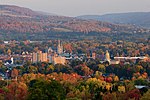1890 House Museum

The 1890 House Museum is a historic house located on Tompkins Street in Cortland, New York. It was built in 1890 for industrialist Chester F. Wickwire (1843–1910), and was designed by architect Samuel B. Reed. The beautiful mosaic stained glass windows throughout the home were created by Henry F. Belcher. Chester Wickwire lived in the home from 1890 until his death in 1910. He made his fortune by founding and managing the Wickwire Brothers Company in Cortland, NY, which produced wire products such as horse muzzles, seed spreaders, insect screens, and similar products for rural Americans.In 1974, the 1890 House Museum formed a part of the Tompkins Street District's listing on the National Register of Historic Places, and in 1975, the 1890 House became a museum after campaigning from Cortland County leaders.
Excerpt from the Wikipedia article 1890 House Museum (License: CC BY-SA 3.0, Authors, Images).1890 House Museum
State Highway 13,
Geographical coordinates (GPS) Address Phone number Website External links Nearby Places Show on map
Geographical coordinates (GPS)
| Latitude | Longitude |
|---|---|
| N 42.596138888889 ° | E -76.182222222222 ° |
Address
1890 House
State Highway 13 37
13045 , District 1 (Ward 5)
New York, United States
Open on Google Maps










